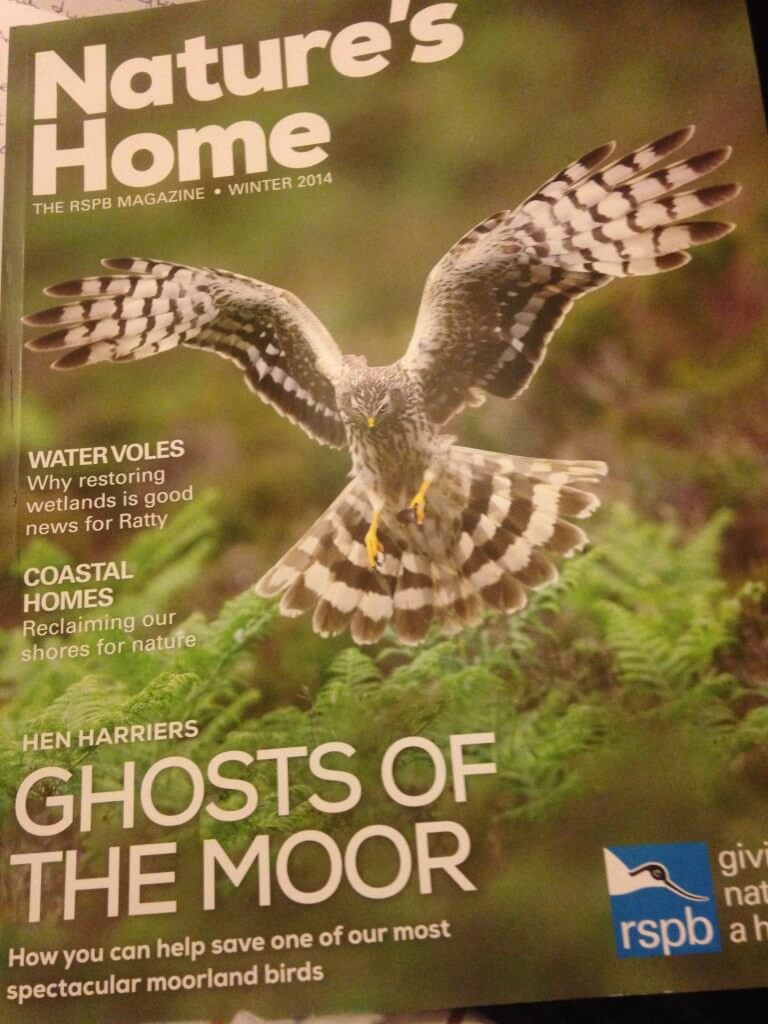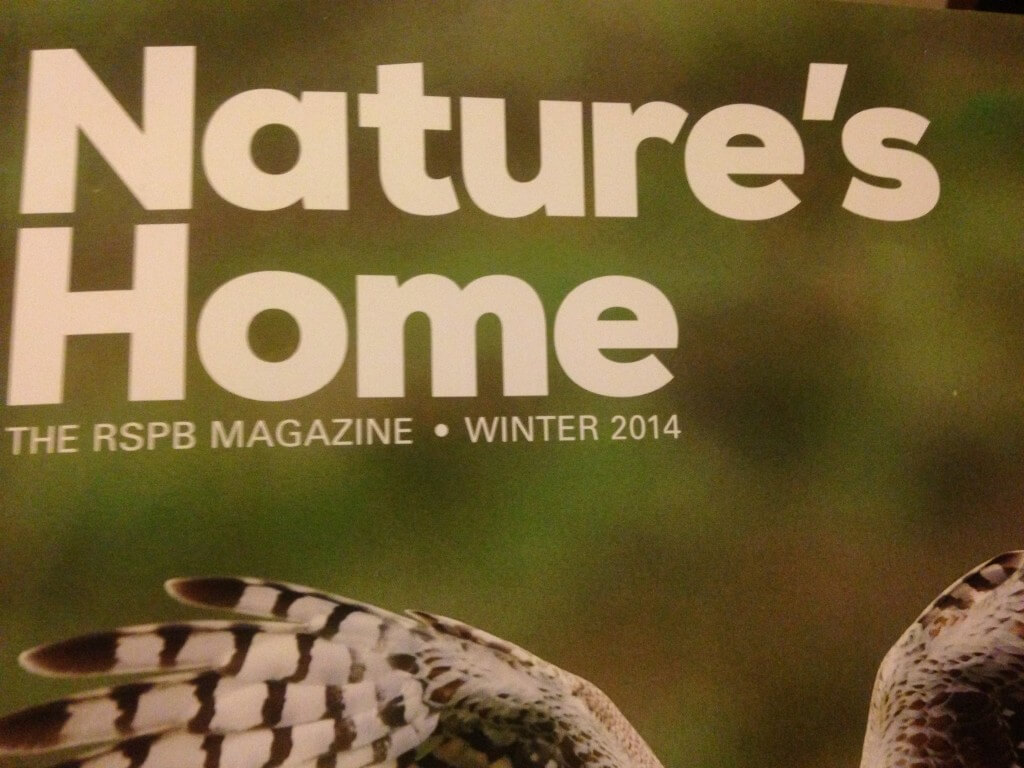I was beginning to wonder whether my ‘A magazine formerly known as BIRDS‘ had gone astray. My mum had received hers, my daughter had hers, the lady in the Post Office mentioned that she had had hers too. I know the RSPB was founded by a group of women but I don’t remember the magazine being sent out ‘ladies-first’.
 But yesterday mine arrived too. And what a fine cover it has! A ringtail Hen Harrier (and it could have been a squirrel called Bob!).
But yesterday mine arrived too. And what a fine cover it has! A ringtail Hen Harrier (and it could have been a squirrel called Bob!).
Inside there are pages and pages on Hen Harriers: there is a long, excellent article by Stuart Winter, a mention of them by Martin Harper, another mention in Mike Clarke’s opening piece and also mention of satellite tagging of Montagu’s Harriers and the excellent Simon Barnes railing at raptor persecution – didn’t he use to do that in The Times (he’s amongst friends here)?
The RSPB gives a few words on page 53 to three options for making things better. One, on the far right of the article, is the Moorland Association’s ‘There, there, it’s alright really. Don’t you worry your pretty little heads about it’ approach (although maybe you’d better read it for yourself), and in the centre is the RSPB’s pitch for licensing of grouse shooting and on the far left is my ‘Ban it!‘ suggestion.
The RSPB and I are in complete agreement about the problem and the cause of the problem, but we have a difference of opinion, a friendly difference of opinion, about the solution.
 The RSPB states that self-regulation has failed and that sites are being destroyed and damaged by poor grouse moor management, and that birds of prey are persecuted. Yes, self regulation has failed, but so has actual regulation in this case. It isn’t legal to damage important wildlife sites or to kill birds of prey – and yet it happens. It happens because it is difficult to catch the miscreants and the grouse moor owners are rich and powerful. Neither of those reasons is removed by a ‘stronger’ form of regulation. Regulation will fail in future as it has failed in the past because it is very difficult to bring the guilty to court.
The RSPB states that self-regulation has failed and that sites are being destroyed and damaged by poor grouse moor management, and that birds of prey are persecuted. Yes, self regulation has failed, but so has actual regulation in this case. It isn’t legal to damage important wildlife sites or to kill birds of prey – and yet it happens. It happens because it is difficult to catch the miscreants and the grouse moor owners are rich and powerful. Neither of those reasons is removed by a ‘stronger’ form of regulation. Regulation will fail in future as it has failed in the past because it is very difficult to bring the guilty to court.
That’s why the only workable solution on the table, and on page 53 of Nature’s Home magazine, is to ban driven grouse shooting. I’m grateful to the RSPB for the space they have given to this matter and I’ll be even more grateful to RSPB members who read the articles, think about it and then sign up for a ban to driven grouse shooting.
[registration_form]


It will be interesting to see if the release of the magazine…..with the reference to the petition , leads to a spike in sign ups.
Mark, I was slightly concerned that whilst all 3 of you are given the opportunity to put your point of view in a quote, to get to that point you will first have read the overview section which I found focused more on the economic and conservation benefits of driven grouse shooting . You really have to think about the figures quoted before you can understand them e.g. One bubble saying 67.7 million into the economy from grouse shooting in England and Wales. Another saying 60 million given by the public funding to grouse moors in England. That doesn’t look like an economic benefit to me.
I think that this publication came out at an unfortunate time for this argument. Clearly printed some time ago and able to promote the increase in Hen and Montagu’s Harrier breeding but too late to point out that a high percentage of those birds have already disappeared.
Yes it’s a shame, as Bob Philpott points out, that a high percentage of this year’s young have disappeared. Stuart’s article quotes three Bowland nests and 5 young. Is it possible for RSPB / NE, or anyone else come to that, to state exactly what the position is. I thought it was established as two Bowland nests, one Peak District nest and one other being kept quiet for good reason. So how many young did fledge, how many were fitted with satellite tracking, and just how few of those young are surviving? I think we’re missing a very pessimistic outcome on what many were hailing as an optimistic season for English hen harriers.
As chance would have it I am reading this from a hotel outside Lancaster where I enjoyed a very pleasant pint of ‘Hen Harrier’ last night, brewed by the Bowland Brewery. I see that they also brew a beer called ‘Skydancer’. Let’s hope that in years to come these are not the only hen harriers to be found in the Forest of Bowland.
On page 52 the opening gambit paragraph said driven grouse shooting – is an important use of the UK’s upland areas! Whose opinion are they quoting here????
Three hen harriers in England lost recently to predation:
‘We are very saddened by the deaths of three of the hen harrier chicks. All indications are that two of the birds were killed by a natural predator. The body of the third has been recovered and, along with the remains of the other two, has been sent for post-mortem (as is usual practice), but there is no evidence of suspicious activity at this stage’
http://peakdistrictnt.blogspot.com/2014/09/hen-harrier-chick-update-12-september.html
How many evidenced to have been lost in England this year to persecution?
Monro – shall we start with the disappearances of Hope and Sky? And how many others are missing – do you know? And what proportion of harriers are tagged?
But you appear to be the only person these days who does not accept the science that the main cause of lack of Hen Harriers is illegal killing by grouse moor interests.